Ciidae
Cristiano Lopes-Andrade


This tree diagram shows the relationships between several groups of organisms.
The root of the current tree connects the organisms featured in this tree to their containing group and the rest of the Tree of Life. The basal branching point in the tree represents the ancestor of the other groups in the tree. This ancestor diversified over time into several descendent subgroups, which are represented as internal nodes and terminal taxa to the right.

You can click on the root to travel down the Tree of Life all the way to the root of all Life, and you can click on the names of descendent subgroups to travel up the Tree of Life all the way to individual species.
For more information on ToL tree formatting, please see Interpreting the Tree or Classification. To learn more about phylogenetic trees, please visit our Phylogenetic Biology pages.
close boxIntroduction
Ciidae is a family of minute beetles with nearly 650 described species in 42 genera, and hundreds of new forms known from museum and private collections (Lawrence 1967b; Lawrence 1971; Lawrence and Lopes-Andrade 2010; Lopes-Andrade and Lawrence 2005; Lopes-Andrade 2008b; Mellié 1849). Although distributed worldwide, the group is most diversified and least studied in subtropical and tropical regions. Ciids are diverse and abundant in most terrestrial environments, with both specialist and generalist species, endemic and widely distributed species, and so they are particularly suitable for broad ecological and biogeographical studies.
Biology and Ecology
Most ciids are true mycetobionts: Larvae and adults both live and breed in reproductive structures (basidiomes) of macrofungi (Lawrence 1973; Orledge and Reynolds 2005). They usually tunnel into and feed internally on the sterile supporting tissue of the more persistent basidiomes (Lawrence and Lopes-Andrade 2010). The most common hosts are from the families Polyporales and Hymenochaetales, but species of Orthocis Casey usually breed in Auriculariales (Lawrence and Lopes-Andrade 2010; Lopes-Andrade 2010b). The hosts are usually colonized after spores have been shed and sometime long after the fungus dies (Lawrence and Lopes-Andrade 2010). However, there are field observations and experimental evidence showing that ciids may consume live fungus and cause a significantly decrease in the area of functional hymenium, reducing fungal reproductive fitness (Guevara et al. 2000). Therefore, ciids may be considered saprophagous on decaying basidiomes or parasites of live fungi. In the latter perspective, the evolution of certain characteristics of ciid host fungi (such as chemical composition, consistency and phenology) can be interpreted as being driven by fungivory. Adults of apterous and micropterous species are usually collected in leaf-litter, but it is still unknown whether they are saprophagous on debris or associated with microfungi, or are found there while dispersing between basidiomes (Lopes-Andrade 2007a).
Ciidae are possibly the most speciose, frequent and abundant beetles associated with persistent basidiomes that grow in dead or live tree-trunks, and so they are directly involved in the decaying process of these fungal structures. In doing so, the ciids render important environmental services in nutrient cycling of elements such as cadmium, chromium, molybdenum, manganese and selenium, which are usually concentrated ten times more in basidiomes than in the substrate they use. Basidiomes are rich in proteins and carbohydrates and have great amounts of biologically important elements such as phosphorus and nitrogen, which may accelerate the development of larvae of beetles feeding on them (Martin 1979). However, basidiomes also have high concentrations of toxins, such as phenols, pyrones and heterocyclic nitrogen complexes. As the ciids are successful in consuming basidiomes they certainly have physiological mechanisms to avoid the toxic effects of these substances.
Characteristics
Ciids are tiny beetles and adults of most species have a length of 1 to 3 mm. However, a few species may be near 0.5 mm long, and some Cis Latreille and Xylographus Mellié may be “very large” and reach around 7 mm. Sexual dimorphisms occurs in the majority of species, in which males have tubercles and/or horns in the frontoclypeal ridge and/or the anterior pronotal margin. Males of most species also have a sex patch at the first abdominal ventrite that is possibly glandular and involved in sexual pheromone secretion (Lopes-Andrade et al. 2003). In one species, Phellinocis romualdoi Lopes-Andrade & Lawrence, females also have such an abdominal sex patch, but it is smaller than in males (Lopes-Andrade and Lawrence 2005). In Cis taurus (Reitter), Ceracis cornifer (Mellié) and others, frontoclypeal horn(s) may be as long as or even longer than pronotum.
Ciidae (except for Sphindocis denticollis Fall) may be recognized by the combination of morphological features provided below (sensu Lawrence 1974b; Lawrence and Lopes-Andrade 2010):
Adults:
- Antennal club with three antennomeres, rarely with two.
- Each antennomere of the club with at least four sensillifers (compound sensillae).
- Ligula reduced or absent.
- Each maxillary palpus with four palpomeres.
- Each labial palpus with three palpomeres.
- Mandibles bidentate.
- Tarsal formula 4-4-4, in which the last is longer than the previous three tarsomeres together.
- Five visible abdominal ventrites, which are not connate.
- First abdominal ventrite in males usually with a sex patch.
- Aedeagus symmetrical, with short, broad, ventral phallobase (=basal piece), usually overlapping the apicale (fused parameres=tegmen) and dorsal penis.
- Anterior edge of phallobase without struts.
- Spermatheca not conspicuous (very small and barely sclerotized).
- Sternite VIII in females with well-developed anterior strut (spiculum ventrale).
The tarsal formula is described as 3-3-3 in Trichapus Friedenreich and Paratrichapus Scott (Friedenreich 1881; Scott 1926). Trichapus includes two species: T. pubescens Friedenreich, the type-species, which is possibly a Cis of the taurus gp.; and T. glaber Friedenreich, which is possibly a Porculus (Lawrence 1987). The drawings and description of Paratrichapus sechellarum Scott, the unique species of the genus, shows that it’s possibly a Xylographus (see Scott 1926). Therefore, their tarsal formula is possibly 4-4-4, rather than 3-3-3.
Similar antennal sensillifers occur in other tenebrionoids, especially in some Tenebrionidae (Lawrence 1971), and a sex patch in the first abdominal ventrite occurs in species of unrelated polyphagan families such as Anthribidae, Bruchidae, Erotylidae and Tenebrionidae (Faustini and Halstead 1982).
Larvae:
- Head with epicranial stem long, usually with median endocarina beneath it.
- Head usually with three to five stemmata on each side, rarely two, one or none.
- Antennae very small, each with two antennomeres.
- Frontoclypeal suture present and labrum free.
- Mandibles large, robust and more or less asymmetrical, bidentate, without true mola, sometimes with pseudomola.
- Lacinia represented by short, truncate, subapical lobe.
- Maxillae free to about middle of mentum, without an articulating sclerite at its base.
- Spiracles annular or annular-uniforous (“unicameral”).
- Ninth tergum variously modified, usually with two urogomphi.
- Ninth sternum without asperities.
Body elongate, more or less parallel-sided, subcylindrical, slightly curved ventrally. Surfaces relatively smooth and usually lightly pigmented, except for mouth frame and tips of urogomphi, rarely with light tergal plates on most segments, smooth with vestiture of scattered, long simple setae (Costa et al. 1988; Lawrence and Lopes-Andrade 2010). Ciidae larvae have barely been studied and so it is early to provide general morphological patterns for the currently accepted suprageneric taxa.
Collecting and Breeding
Ciids are usually collected inside basidiomes of poroid fungi or by sifting litter. They are rarely attracted to light sources, so they are not frequently caught by malaise or other light traps. After collecting basiodiomes, it is important to let moisture evaporate before sorting the ciids.
If the aim is to breed ciids, basidiomes should be kept in plastic containers together with a small vial of silica gel or other another drying agent. Ciids are easily maintained under laboratory conditions and can be bred for several generations without addition of water or food (Klopfenstein and Graves 1992; Lopes-Andrade pers. obs.). Up to ten thousand individuals may live inside a single basidiome (Navarrete-Heredia 1987) and generation overlap is usually observed (Lawrence 1971).
Predators, Parasitoids and Phoretic Mites
Ciids have a patchy distribution, since they are usually aggregated in large numbers inside basidiomes. Therefore, they may be a major resource for several arthropods (Lawrence 1974a). A few ant species (mainly of Wasmannia Forel and Pheidole Westwood) were already observed performing aggressive behavior against adults and immatures of ciids (Lopes-Andrade pers. obs.), and Temnochila sp. (Coleoptera: Trogossitidae), Lyctocotis sp. (Heteroptera: Anthocoridae) and larvae of Lestodiplosis Kieffer (Diptera: Cecidomyiidae) are known to be predators (Lawrence 1974a). Several species of Allocerastichus Masi and Astichus Foerster (Eulophidae), Meteoms Haliday and Eubazus Nees (Braconidae), Jirnssoniella cuudata Kerrich (Pteromalidae), Plustanoxus chittendendi Ashmead and Cephalonornia perpusilla Evans (Bethylidae) are parasitoids of ciids (Coote 1994; Lawrence 1974a; Orledge et al. 2010). Phoretic mites, such as several species of Boletoglyphus Volgin and Boletacarus Volgin & Mironov (Acaridae), are commonly found on adult ciids (Klimov 1998).
Ciids as Pest and Invasive Organisms
Hadreule blaisdelli (Casey) was already recorded as a pest of fungi and lichen of North American herbaria (Lawrence 1971). Cis chinensis Lawrence is a known pest of commercial dried-fungi and is already free-living in Brazil, continental Europe, Asia and Réunion (Lopes-Andrade 2008a; Rose 2009). A few other ciids also have disjunct distributions and are considered invasive species in several regions, such as Ceracis cucullatus (Mellié), Cis bilamellatus Wood, Cis boleti (Scopoli), Cis creberrimus Mellié and Cis fuscipes Mellié (Lawrence 1971; Lopes-Andrade et al. 2009; Lopes-Andrade pers. obs.; Orledge et al. 2010).
Conservation Biology
There are evidences that ciids are affected by forest fragmentation and forest management. At least one species, Falsocis brasiliensis Lopes-Andrade, may be threatened (Lopes-Andrade 2007b). The species has a clearly disjunct distribution in the southern Neotropical region, occurring only in very small forest remnants in southeastern and northeastern Brazil. It has been barely collected, except for a great collection effort in recent years (Lopes-Andrade pers. obs.). Other ciid species are restricted to forest remnants and/or occur in threatened biomas, such as the Brazilian Atlantic Forest, and their conservation status should be evaluated.
Taxonomy
- Sphindociinae
- Sphindocis Fall, 1917
- Ciinae
- Ciini
- Acanthocis Miyatake, 1954
- Anoplocis Kawanabe, 1996
- Apterocis Perkins, 1900
- Atlantocis Israelson, 1985
- Ceracis Mellié, 1849
- Cis Latreille, 1796
- Cisarthron Reitter, 1885
- Dichodontocis Kawanabe, 1994
- Dimerapterocis Scott, 1926
- Diphyllocis Reitter, 1885
- Dolichocis Dury, 1919
- Ennearthron Mellié, 1847
- Euxestocis Miyatake, 1954
- Falsocis Pic, 1916
- Hadreule Thomson, 1859
- Lipopterocis Miyatake, 1954
- Malacocis Gorham, 1886
- Neoapterocis Lopes-Andrade, 2007
- Neoennearthron Miyatake, 1954
- Nipponapterocis Miyatake, 1954
- Nipponocis Nobuchi & Wada, 1955
- Odontocis Nakane & Nobuchi, 1955
- Orthocis Casey, 1898
- Paraxestocis Miyatake, 1954
- Phellinocis Lopes-Andrade & Lawrence, 2005
- Plesiocis Casey, 1898
- Polynesicis Zimmerman, 1938
- Porculus Lawrence, 1987
- Strigocis Dury, 1917
- Sulcacis Dury, 1917
- Trichapus Friedenreich, 1881
- Wagaicis Lohse, 1964
- Orophiini
- Hyalocis Kawanabe, 1993
- Octotemnus Mellié, 1847
- Paratrichapus Scott, 1926
- Ropalodontus Mellié, 1847
- Xylographus Mellié, 1847
- Xylographellini
- Xylographellina
- Scolytocis Blair, 1928
- Xylographella Miyatake, 1985
- Syncosmetina
- Syncosmetus Sharp, 1891
- Tropicis Scott, 1926
Relationship of Ciidae to other Cucujiformia
There are few available studies shedding light on the relationship of Ciidae to other cucujiform families, and internal relationships of the family are barely known. A phylogenetic analysis based on larval characters sustained Tenebrionoidea, including Ciidae and Prostomidae, as a clade defined by several autapomorphies (Beutel and Friedrich 2005). Ciidae is usually regarded as belonging to a tenebrionoid assemblage including Archeocrypticidae, Mycetophagidae, Prostomidae and Pterogeniidae (Buder et al. 2008; Lawrence 1971, 1982). However, there is no published work based on morphological and/or molecular data comprising species of all these families and a sufficient sample of cucujiform lineages to test this relationship.
The single published phylogenetic analysis, based on molecular data of several Ciidae taxa and species of other cucujiform families as outgroups, showed that Ciidae (Sphindociinae and Xylographellini were not included) is monophyletic (Buder et al. 2008). The authors found two alternatives for the relationship of Ciidae to other families: (i) Ciidae as an isolated clade in a cucujoid-tenebrionoid assemblage, sister to a clade comprising Anthicidae, Latridiidae, Monotomidae and Nitidulidae; (ii) a sister-group relationship to Nitidulidae. The authors emphasized that Archeocrypticidae and Pterogeniidae were not analyzed, so a close relationship to Ciidae could not be refuted. However, in none of the performed analyses did Ciidae appear close to Mycetophagidae, Tenebrionidae or Tetratomidae.
Discussion of Phylogenetic Relationships
The current suprageneric classification of Ciidae does not reflect any robust phylogenetic scenario. The Californian Sphindocis denticollis (Sphindociinae) was included in the family based on the distinctive laciniar lobe of the larval maxilla, a feature not seen in any other cucujiform taxa (Lawrence 1974b). Among Ciinae, the most well-defined suprageneric taxon is Xylographellini, with the following possible apomorphies (Lopes-Andrade 2008b): (i) Antennal club compact; (ii) Each antennomere of the club bearing more than four sensillifers; (iii) Labial palpi inserted at the middle of prementum; (iv) Cuticular surface with small scattered globules, especially on pronotum and elytra; (v) Sternite IX in male with spiculum gastrale. Ciini and Orophiini do not have any well-defined apomorphy.
References
Beutel, R.G. and F. Friedrich. 2005. Comparative study of larvae of Tenebrionoidea (Coleoptera: Cucujiformia). European Journal of Entomolology, 102: 241-264.
Bouchard, P., Y. Bousquet, A.E. Davies, M.A. Alonso-Zarazaga, J.F. Lawrence, C.H.C. Lyal, A.F. Newton, C.A.M. Reid, M. Schmitt, S.A. Ślipiński and A.B.T. Smith. 2011. Family-group names in Coleoptera (Insecta). ZooKeys, 88: 1-972.
Buder, G., C. Grossmann, A. Hundsdoerfer and K.-D. Klass. 2008. A contribution to the phylogeny of the Ciidae and its relationships with other cucujoid and tenebrionoid beetles (Coleoptera: Cucujiformia). Arthropod Systematics & Phylogeny, 66(2): 165-190.
Coote, L.D. 1994. Review of Nearctic genera of Euderinae (Hymenoptera: Eulophidae), with descriptions of two new species of Allocerastichus Masi, and redescription of Carlyleia marilandica Girault. Canadian Journal of Zoology, 72: 1044-1054.
Costa, C., S.A. Vanin and S.A. Casari-Chen. 1988. Larvas de Coleoptera do Brasil. Museu de Zoologia da Universidade de São Paulo, São Paulo. 282 pp.
Faustini, D.L. and D.G.H. Halstead. 1982. Setiferous structures of male Coleoptera. Journal of Morphology, 173: 43-72.
Friedenreich, C.W. 1881. Trimere Cioiden in Sudbrasilien. Stettiner Entomologische Zeitung, 42: 328-330.
Guevara, G., A.D.M. Rayner and S.E. Reynolds. 2000. Effects of fungivory by two specialist ciid beetles (Octotemnus glabriculus and Cis boleti) on the reproductive fitness of their host fungus, Coriolus versicolor. New Phytologist, 145: 137-144.
Kawanabe, M. 2002. A Revision of the genus Octotemnus (Coleoptera, Ciidae) from Japan. Japanese Journal of Systematic Entomology, 8(2): 243-267.
Klimov, P.V. 1998. Review of mites of the genus Boletoglyphus (Acariformes, Acaridae). Entomological Review, 78(9): 1094-1101.
Klopfenstein, W.G. and R.C. Graves. 1992. Morphology of the digestive and reproductive systems of adult Hadraule blaisdelli (Casey) (Coleoptera: Ciidae). The Coleopterists Bulletin, 46(4): 344-356.
Lawrence, J.F. 1965. Comments on some recent changes in the classification of the Ciidae (Coleoptera). Bulletin of the Museum of Comparative Zoology, 133(5): 273-293.
Lawrence, J.F. 1967a. Biology of the parthenogenetic fungus beetle Cis fuscipes Mellié (Coleoptera: Ciidae). Breviora, 258: 1-14.
Lawrence, J.F. 1967b. Delimitation of the genus Ceracis (Coleoptera: Ciidae) with a revision of North American species. Bulletin of the Museum of Comparative Zoology, 136: 91-143.
Lawrence, J.F. 1971. Revision of the North American Ciidae (Coleoptera). Bulletin of the Museum of Comparative Zoology, 142: 419-522.
Lawrence, J.F. 1973. Host preference in ciid beetles (Coleoptera: Ciidae) inhabiting the fruiting bodies of Basidiomycetes in North america. Bulletin of the Museum of Comparative Zoology, 145: 163-212.
Lawrence, J.F. 1974a. The ciid beetles of California (Coleoptera: Ciidae). Bulletin of the California Insect Survey, 17: 1-41.
Lawrence, J.F. 1974b. The larva of Sphindocis denticollis Fall and a new subfamily of Ciidae (Coleoptera: Heteromera). Breviora, 424: 1–14.
Lawrence, J.F. 1982. A Catalog of the Coleoptera of America North of Mexico. Family: Ciidae. United States Department of Agriculture (Agriculture Handbook 529), Washington, D.C., x + 18 pp.
Lawrence, J.F. 1987. A new genus of Ciidae (Coleoptera, Tenebrionoidea) from the Neotropical region. Revista Brasileira de Entomologia, 31(1): 41-47.
Lawrence, J.F. and C. Lopes-Andrade. 2010. Ciidae Leach in Samouelle 1819. In: Beutel, R.G. and R.A.B. Leschen (eds), Handbook of Zoology. Vol. IV Arthropoda: Insecta. Part 39. Coleoptera, Vol. 2: Morphology and Systematics (Elateroidea, Bostrichiformia, Cucujiformia partim). Walter De Gruyter, Berlin, New York, pp. 504-514.
Lohse, G.A. 1967. Familie: Cisidae. In: Freude, H., K.W. Harde and G.A. Lohse (eds), Die Käfer Mitteleuropas, Band 7. Goecke & Evers, Krefeld, pp. 280-295.
Lopes-Andrade, C. 2007a. Neoapterocis, a new genus of apterous Ciidae (Coleoptera: Tenebrionoidea) from Chile and Mexico. Zootaxa, 1481: 35-47.
Lopes-Andrade, C. 2007b. Notes on Falsocis Pic (Coleoptera: Tenebrionoidea: Ciidae), with the description of an endangered Brazilian species. Zootaxa, 1544: 41-58.
Lopes-Andrade, C. 2008a. An essay on the tribe Xylographellini (Coleoptera: Tenebrionoidea: Ciidae). Zootaxa, 1832: 1-110.
Lopes-Andrade, C. 2008b. The first record of Cis chinensis Lawrence from Brazil, with the delimitation of the Cis multidentatus species-group (Coleoptera: Ciidae). Zootaxa, 1755: 35-46.
Lopes-Andrade, C. 2010a. Two new species of Cis Latreille (Coleoptera: Ciidae) from Chile. Zootaxa, 2441: 53-62.
Lopes-Andrade, C. 2010b. The first record of Orthocis Casey (Coleoptera: Ciidae) from the Andean Region, with the description of a distinctive new species. Zoological Science, 27: 830-833.
Lopes-Andrade, C. and J.F. Lawrence. 2005. Phellinocis, a new genus of Neotropical Ciidae (Coleoptera: Tenebrionoidea). Zootaxa, 1034: 43-60.
Lopes-Andrade, C., F. Gumier-Costa and C.F. Sperber. 2003. Why do male Xylographus contractus Mellié (Coleoptera: Ciidae) present abdominal fovea? Evidence of sexual pheromone secretion. Neotropical Entomology, 32(2): 217-220.
Lopes-Andrade, C., M.S. Madureira and A.A. Zacaro. 2002. Delimitation of the Ceracis singularis group (Coleoptera: Tenebrionoidea: Ciidae), with the description of a new Neotropical species. Dugesiana, 9(2): 59-63.
Lopes-Andrade, C., N. Matushkina, G. Buder and K.-D. Klass. 2009. Cis pickeri sp. nov. (Coleoptera: Ciidae) from Southern Africa. Zootaxa, 2117: 56-64.
Madenjian, J.J., J.D. Eifert and J.F. Lawrence. 1993. Ciidae: newly recognized beetle pests of commercial dried mushrooms. Journal of Stored Products Research, 29: 45-48.
Martin, M.M. 1979. Biochemical implications of insect mycophagy. Biological Reviews, 54: 1-21.
Mellié, J. 1849. Monographie de l’ancien genre Cis des auteurs. Annales de la Société Entomologique de France, 6(2), 205-274, 313-396.
Miyatake, M. 1954. Studies on the Japanese Ciidae, I (Coleoptera). Scientific Reports of the Matsuyama Agricultural College, 14: 40-67, pls. 1-11.
Navarrete-Heredia, J.L. 1987. Ceracis similis Horn (Coleoptera: Ciidae) asociado a Ganoderma lobatum (Schw.) Atk (Basidiomycetes: Polyporaceae). Folia Entomologica Mexicana, 72: 161-162.
Orledge, G.M. and R.G. Booth. 2006. An annotated checklist of British and Irish Ciidae with revisionary notes. The Coleopterist, 15(1): 1-16.
Orledge, G.M. and S.E. Reynolds. 2005. Fungivore host-use groups from cluster analysis: patterns of utilisation of fungal fruiting bodies by ciid beetles. Ecological Entomology, 30: 620-641.
Orledge, G.M., P.A. Smith and S.E. Reynolds. 2010. The non-pest Australasian fungivore Cis bilamellatus Wood (Coleoptera: Ciidae) in northern Europe: spread dynamics, invasion success and ecological impact. Biological Invasions, 12: 515-530.
Rose, O. 2009. Cis chinensis Lawrence, 1991 nouveau pour la faune de France métropolitaine et celle de l’île de La Réunion (Coleoptera Tenebrionoidea Ciidae). L’Entomologiste, 65(5): 281-284.
Ruta, R. 2003. Rhopalodontus lawrencei n. sp. – the first Rhopalodontus species in the Oriental Region. Genus, 14(3): 363-369.
Sandoval-Gómez, V.E., C. Lopes-Andrade and A.A. Zacaro. 2011. Xylographus globipennis Reitter, 1911 (Coleoptera: Ciidae): A barely studied species with broad distribution in the Afrotropical region. Entomological Science, 14: 326–332.
Scott, H. 1926. Coleoptera, Ciidae. Reports of the Percy Sladen Trust Expedition to the Indian Ocean in 1905. Vol. 8, No. 1. Transactions of the Linnean Society of London, Ser. 2. Zoology, 19(1): 1-41.
Thayer, M.K. and J.F. Lawrence. 2002. 98. Ciidae Leach in Samouelle 1819. In: Arnett, R.H., Jr., M.C. Thomas, P.E. Skelley and J.H. Frank (eds), American Beetles. Volume 2. Polyphaga: S carabaeoidea through Curculionoidea. CRC Press, Boca Raton, Florida, pp. 403-412.
Title Illustrations

About This Page
Cristiano Lopes-Andrade

Universidade Federal de Viçosa, Viçosa, Minas Gerais, Brasil
Correspondence regarding this page should be directed to Cristiano Lopes-Andrade at
ciidae@gmail.com
Page copyright © 2011 Cristiano Lopes-Andrade
All Rights Reserved.
- First online 01 May 2011
- Content changed 17 August 2011
Citing this page:
Lopes-Andrade, Cristiano. 2011. Ciidae . Version 17 August 2011. http://tolweb.org/Ciidae/10303/2011.08.17 in The Tree of Life Web Project, http://tolweb.org/





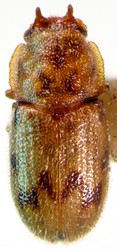
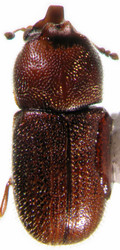
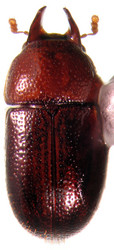
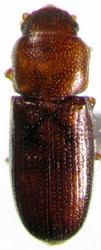
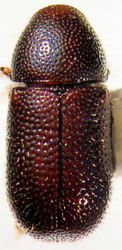
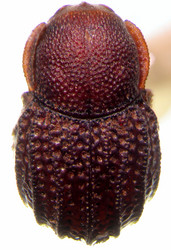
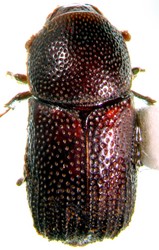








 Go to quick links
Go to quick search
Go to navigation for this section of the ToL site
Go to detailed links for the ToL site
Go to quick links
Go to quick search
Go to navigation for this section of the ToL site
Go to detailed links for the ToL site